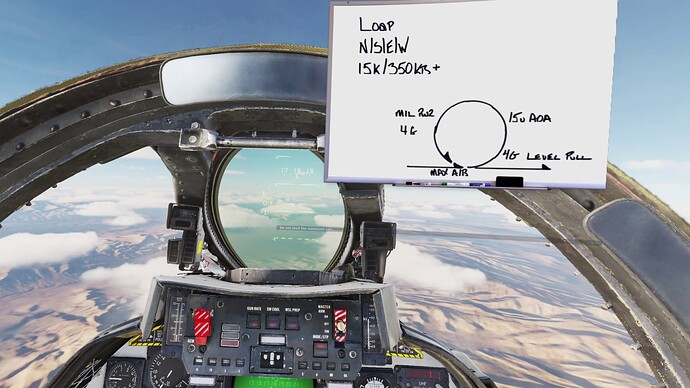I just started Reflected’s F-14B campaign, Speed and Angels, and love the whole RAG/FRS aspect. Doing everything the Navy way isn’t easy, and probably not many people’s idea of fun, but it’s rewarding. The included gradesheet I think is the thing that keeps pushing me forward. You get one of four grades for each item: Above Average, Average, Below Average, and Unsatisfactory. The immersion is great with Paco and Meagan voicing main characters, plus random radio chatter while out at the Nellis ranges.
I’ve did highlight videos on YouTube but thought I’d do more exposition on the flights with some AARs here as well. Sadly since I only fly VR all I got for pictures is in-cockpit screengrabs from video footage.
DAY ONE
Fam flight with some aerobatics. Precise aerobatics. Pull this amount of G, that amount of AoA, enter at this altitude and this speed, exit at the same speed. Okay now do all four maneuvers continuously–Squirrel Cage!
My first flight I really struggled with some maneuvers and had to redo them before Paco would let me progress to the next one.
- Level 5G turn: The VVI lags so much and I don’t have good visual/physical feedback to maintain level so I cheated by putting the HUD in TO mode to reference the HUD VVI. In my defense, the BuNo for the jet I’m in was a D in real life so I’d say it’s valid

- Wingover: It seems so simple yet isn’t. 45 nose up, gentle 180 turn, 90AoB at the 90 as the nose falls, slowly roll out opposite heading. All the stuff between the start, 90, and end was just weird for me.
- Loop: I had trouble feeling out when to transition from G to AoA, then back from AoA to G.
- High alpha: We get going at 100kts and dance on the rudders. Honestly for me this was a hardware issue since my Saitek Pros have no resistance and are very sensitive. If I’m 20~30 units they’re fine, but on this hop we were legit maxing out that AoA tape. It was nuts.
Then we did a zoom climb from 450kts on the deck, followed by some Mach turns. I didn’t get specific instruction on burner use once I hit the prescribed M1.3, so my silly butt left her in blower the whole time. State 1.0. Flamed out on RTB, managed to glide all the way back to WYPT1 before I had to eject on account of no altitude and unresponsive controls. So…I guess that’s an Unsat?
DAY ONE REFLY
I still struggled with the G/AoA transition on the loop and sloppy wingovers, but I made it back and got my grade.
UP NEXT
Formation, Rejoins, Tac turns, Tanking.












